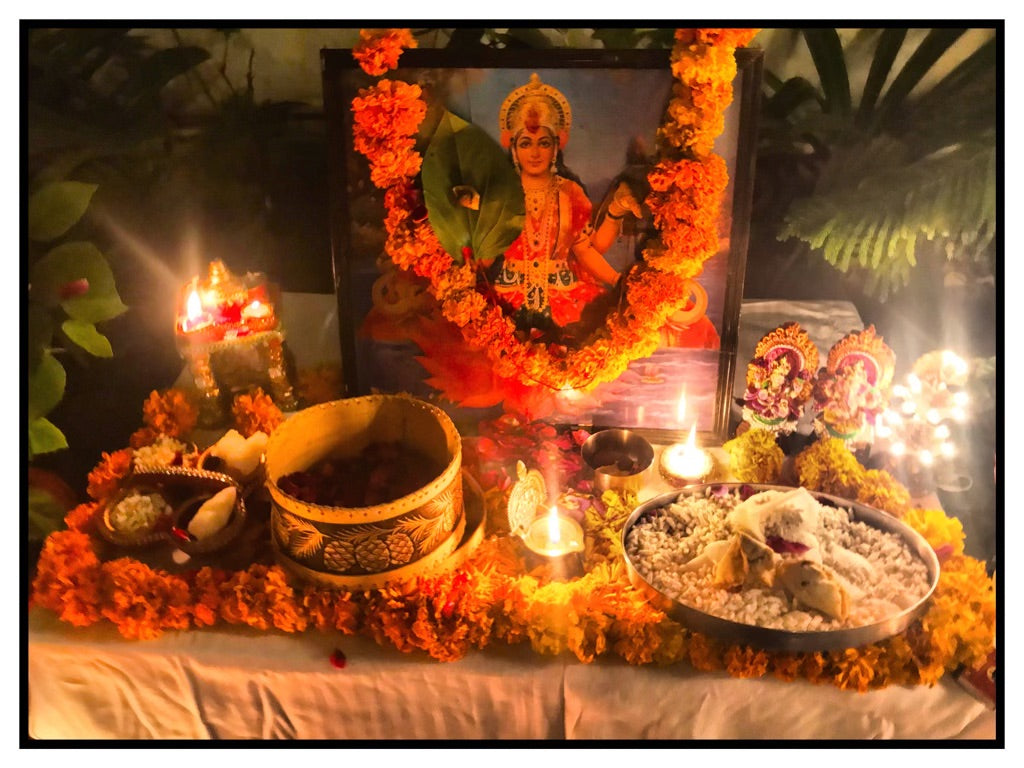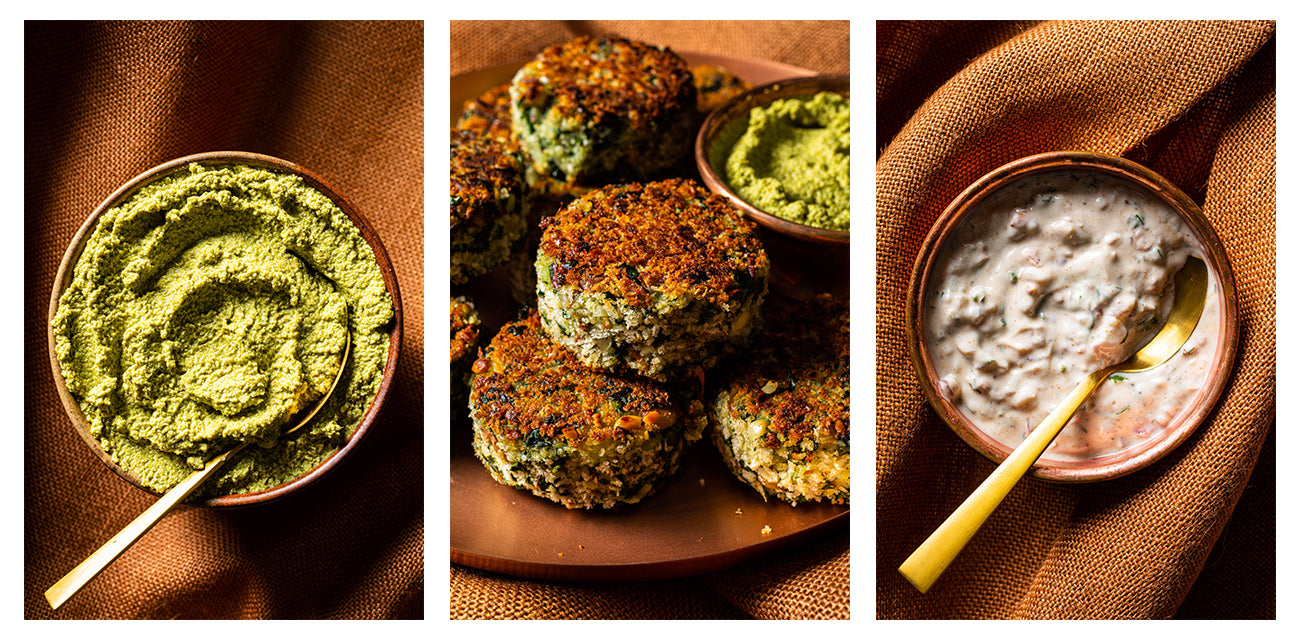My Diwali Story

In celebration of India’s "Festival of Lights," Suvir Suran shared his Diwali story with us and created a menu for a complete celebration meal featuring peanuts.

Guest post by Suvir Saran
Food photography by Stephen Klise and food styling by Elle Simone Scott (unless otherwise noted)
In late Autumn every year, close to a billion people in India and around the world celebrate a beautiful five-day festival called Diwali.
Diwali is called the “Festival of Lights” because it is, literally, a celebration of light and illumination. While Diwali is a Hindi word, it comes from the Sanskrit Deepavali, which means “a row of lights.” The holiday symbolizes the vanquishing of ignorance that overwhelms human life and spirit, and the driving away of darkness with the light of knowledge and hope. We celebrate Diwali in order to embrace hope and the positive values of this life, and to leave behind those thoughts and memories that cloud us in darkness. It’s celebrated with great pageantry across India and is a festival that always leaves me deep in thought. It is also a holiday celebrated with an abundance of delicious food and endless snacks and sweets, which can leave one with several extra pounds of weight due to joyful overindulgence with friends and family!

Photo credit: Devendra Singh, courtesy of the artist
Diwali is linked to the ancient legend of Lord Rama, who was deprived rule of his kingdom and sent to exile for fourteen years with the hope that he would perish. Diwali celebrates Rama’s defeat of the evil spirit, Ravana, and his triumphant return home and ascension to the throne as king. Every region of India has its own distinct way of observing, commemorating, and celebrating Diwali. No matter how local customs may differ, there’s common agreement that the holiday is all about the triumph of good over evil, of light over darkness, and of wisdom and knowledge over ignorance.

Photo courtesy of the author
There is much preparation in the weeks leading up to Diwali: homes are painted, new clothes are bought, and parties are planned, which always seem to include people you’ve never met before but who are destined to become new found friends. Exquisitely rich sweets, each more elaborate than the one before are exchanged between neighbors and friends. These decadent confections are made by reducing milk into a fudge and come in all shapes and sizes. They’re dyed every color in the rainbow using fruit and vegetable extracts, and are garnished with dried fruits and nuts and sometimes even real gold and silver leaf. Arranged in elaborate boxes and tins, many look like jewelry boxes with edible treasures inside. Savory snacks and dishes take on exciting permutations at the hands of skilled home chefs, with each host trying to outdo the other. People eat and drink and make merry and have a lot of fun together.

Photo courtesy of the author
Each of the five days of Diwali has its own significance. Laxmi Puja is the third day and the main celebration and is always celebrated on a moonless night in October or November. On this night Hindus offer prayers to Lakshmi Mata, the goddess of wealth, inviting her inside their homes and asking her to bless every nook and cranny. We also offer prayers to Lord Ganesha who represents good fortune. Then comes a feast of extravagance—samosas, mathris (crackers made with semolina and flour), pakoras (savory fritters), palak singh dana tikkis (vegetable patties with spinach, potato, and peanuts), and all kinds of fried snacks served with chutneys, pickles, and condiments.
In our home we would make a biriyani (rice dish) with jackfruit that was beautifully scented with saffron and cardamom and rosewater. In New York I would make a mushroom biryani and mirchi ka salan (a mélange of peppers cooked in a spiced peanut sauce) that became very popular with family and friends. Every home has its own traditional Diwali meal, but everyone ends the night with a gazillion desserts before people go back to their homes.
There’s gulab jamun (ball-shaped sweet milk cakes), ras malai (flat, round cakes made from strained cheese, sugar and spices), jalebis (deep fried swirls of dough soaked in syrup), rabdi (sweet milk pudding), kaju ki barfi (snow-colored fudge made with cashews), and so many more, but I would usually gravitate towards the kheer (rice pudding), halwa (wheat-based confection with dried fruit and nuts), and kulfi (rich, dense ice cream) knowing that these were probably made at home and with a profusion of love and hours of labor.

India is one of the world’s largest growers of peanuts, with most of the peanuts grown used to produce peanut oil. That said, whole, chopped, and ground peanuts have become key ingredients in recipes for many traditional Indian dishes. To celebrate Diwali this year, I’ve created a menu for a complete Diwali meal that uses peanuts in every dish:
Appetizer: Paalak Mungphali Tikki (Vegetable Patties with Spinach, Peanut, and Potato)
Dips: Singhdana Chutney (Nutty Green Chutney)
Side: Peanut Raita (Yogurt Dip)
Main Course: Mushroom & Peanut Biryani
Dessert: Peanut Butter Kulfi (Frozen Dessert) with Peanut Raisin Chikki (Peanut Brittle)


Many homes put on firework displays for Diwali. In cities the evening skyline is ablaze in color, and homes are outlined with shimmering oil lamps and candles that trace every line of the architecture. Even the ugliest buildings become beautiful during this week of celebration.
On the back porch of our home, my mother would make an altar with grains, sweets, incense, and oil lamps. She would use colored powders from vegetable pigments to create beautiful, elaborate geometric designs on the floor called rangoli. She would place countless candles and oil lamps within the pattern that would enhance the colors and make the shapes dance in the golden light. Multicolored plants and flower arrangements were placed behind and around the rangoli to make it even more festive.

I learned the art of decorating at a young age by watching my mother create these illuminated works of art. I learned how a festival is as much about bringing back memories of generational activities as it is a celebration of life and happiness and goodness and abundance and prosperity, because it connects the dots from the past to our hopes for future years. Diwali is full circle and yet always going forward.
Diwali gives me great reason to believe in the larger good that prevails in all of us, across borders and oceans. Irrespective of our beliefs, our spoken languages, and our ethnic makeup, we are all wanting the same magic to touch our lives. We all have dreams. We all have love to share and crave. We all want to grow and support each other. We all rise and fall, laugh and cry, breathe and eventually stop breathing.

Photo courtesy of the author
My family, like many others, would use Diwali, the Festival of Lights, as a lesson to remind everyone to appreciate the power of illumination inside and out. Beloved grandparents, parents, aunts, and uncles teach the next generation that like these shimmering lights – the candles, the oil lamps, the fireworks – we are disparately beautiful in our own right, but when we shimmer together in unison, we take on the powers of the universe, shining brighter still. In telling us this they showed us how we transcend and harness the power of self, appreciate the wealth of camaraderie, and become one with the planet.
Life that lives inside each of us has no one form. It is what it is: LIFE!
Celebrate Diwali with peanuts in every dish! Get the recipes: Paalak Mungphali Tikki , Singhdana Chutney, Peanut Raita, Mushroom & Peanut Biryani, Peanut Butter Kulfi, Peanut Raisin Chikki
As part of our commemoration of Diwali 2021, Peanut Butter & Co. has made a donation to Alliance India.

